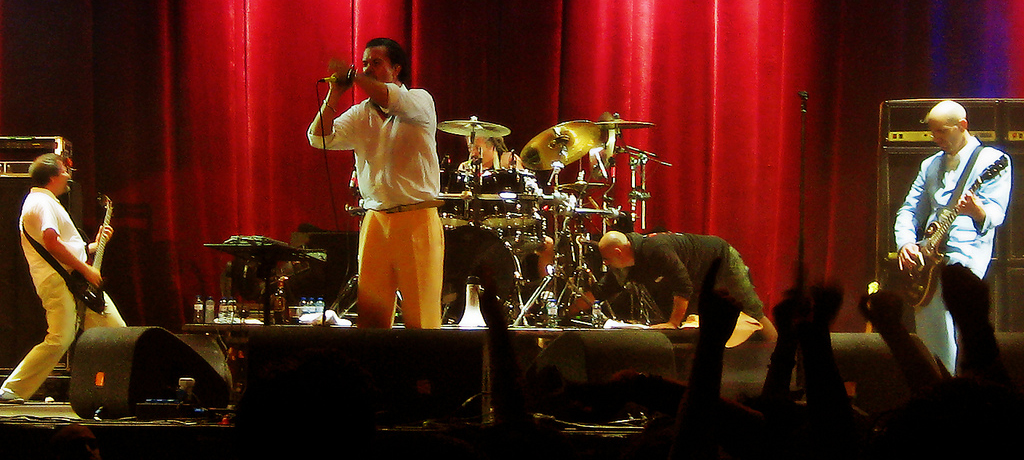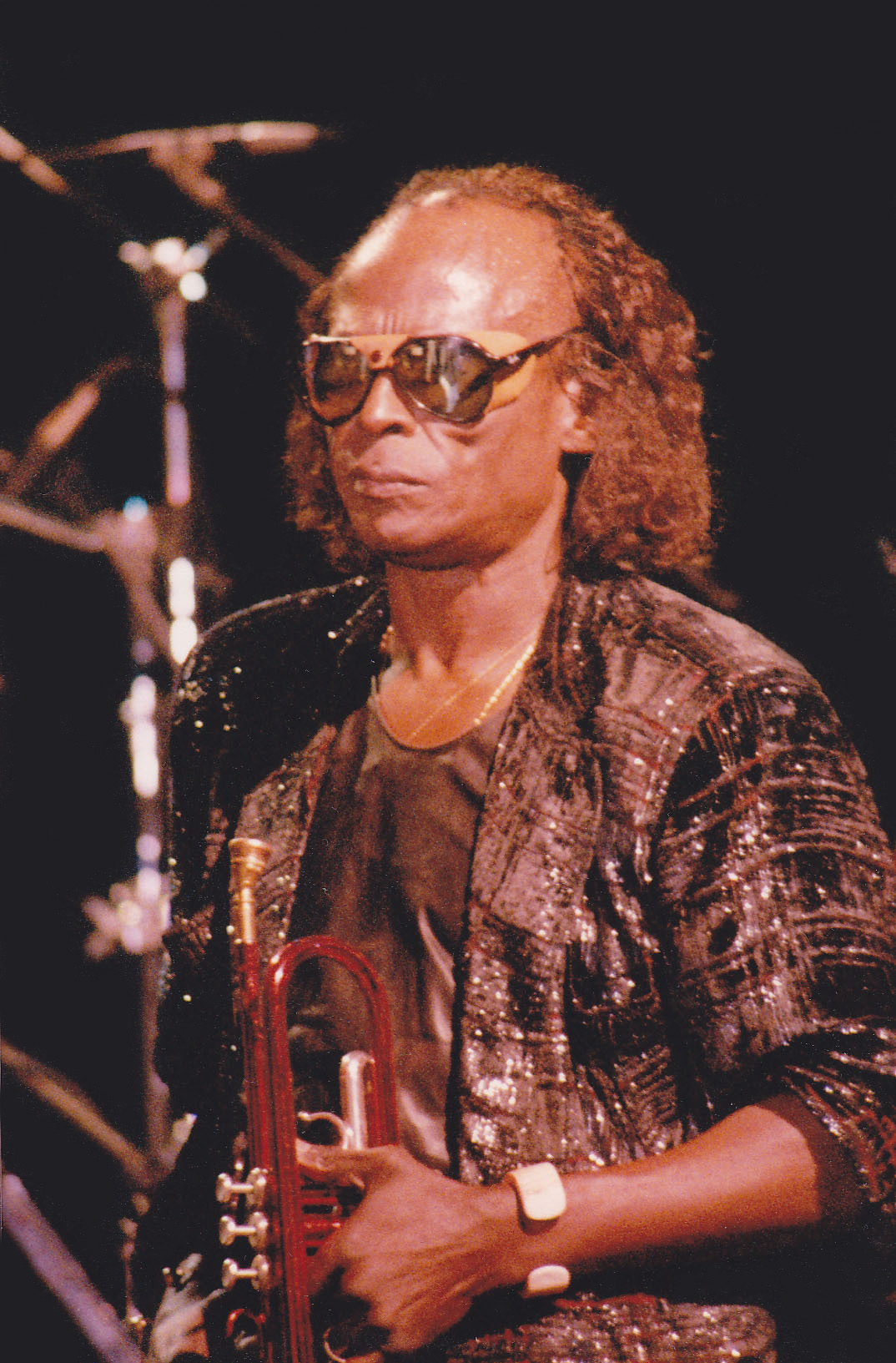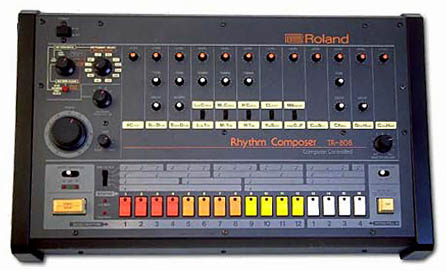|
Funk
Funk is a music genre that originated in African American communities in the mid-1960s when musicians created a rhythmic, danceable new form of music through a mixture of various music genres that were popular among African Americans in the mid-20th century. It de-emphasizes melody and chord progressions and focuses on a strong rhythmic groove of a bassline played by an electric bassist and a drum part played by a percussionist, often at slower tempos than other popular music. Funk typically consists of a complex percussive groove with rhythm instruments playing interlocking grooves that create a "hypnotic" and "danceable" feel. Funk uses the same richly colored extended chords found in bebop jazz, such as minor chords with added sevenths and elevenths, or dominant seventh chords with altered ninths and thirteenths. Funk originated in the mid-1960s, with James Brown's development of a signature groove that emphasized the downbeat—with a heavy emphasis on the first bea ... [...More Info...] [...Related Items...] OR: [Wikipedia] [Google] [Baidu] |
Funk Metal
Funk metal (also known as thrash-funk or punk-funk) is a subgenre of funk rock and alternative metal that infuses heavy metal music (often thrash metal) with elements of funk and punk rock. Funk metal was part of the alternative metal movement, and has been described as a "brief but extremely media-hyped stylistic fad". The funk metal scene formed in California during the mid-1980s with a group of bands who were initially playing a mix of funk, hard rock, hip hop music, hip hop and punk, and it quickly evolved to include elements of thrash metal. Early bands associated with the style in the 1980s included Faith No More, Fishbone and Red Hot Chili Peppers, as well as the New York City, New York band Living Colour. In the early 1990s, the genre expanded with the start of bands like Primus (band), Primus, Infectious Grooves and Rage Against the Machine. Funk metal gained mainstream attention in the late 1980s, when Living Colour and Faith No More experienced chart success with their ... [...More Info...] [...Related Items...] OR: [Wikipedia] [Google] [Baidu] |
Funk Rock
Funk rock is a fusion genre that mixes elements of funk and rock. James Brown and others declared that Little Richard and his mid-1950s road band, The Upsetters, were the first to put the funk in the rock and roll beat, with a biographer stating that their music "spark dthe musical transition from fifties rock and roll to sixties funk." Funk rock's earliest incarnation on record was heard in the late 1960s through the mid-1970s by acts such as the Jimi Hendrix Experience (later work / Band of Gypsys), Eric Burdon and War, Redbone, Rick Derringer, David Bowie, Aerosmith, Wild Cherry, Average White Band, Gary Wright, Trapeze, The Bar-Kays, Black Merda, Parliament-Funkadelic, Betty Davis and Mother's Finest. During the 1980s and 1990s funk rock music experienced a surge in popularity, with bands such as Tom Tom Club, Pigbag, INXS, Talking Heads, Devo, the Fine Young Cannibals and Cameo dabbling in the sound. Groups including Red Hot Chili Peppers, Rage Against the Machine, ... [...More Info...] [...Related Items...] OR: [Wikipedia] [Google] [Baidu] |
G-funk
G-funk, short for gangsta funk, is a sub-genre of gangsta rap that emerged from the West Coast scene in the late 1980s. The genre is heavily influenced by 1970s psychedelic funk (P-funk) sound of artists such as Parliament-Funkadelic. Characteristics G-funk (which uses funk with an artificially altered tempo) incorporates multi-layered and melodic synthesizers, slow hypnotic grooves, a deep bass, heavy use of the snare drum, background female vocals, the extensive sampling of P-Funk tunes, and a high-pitched portamento saw wave synthesizer lead. It is typically set at a tempo of anywhere between 80 to 100 BPM. The lyrical content depended on the artist and could consist of sex, drug use (especially marijuana), love for a city/neighborhood, love for friends and relaxing words. There was also a slurred "lazy" or "smooth" way of rapping in order to clarify words and stay in rhythmic cadence. The trademark West Coast G-funk style of hip-hop was a very defining element of th ... [...More Info...] [...Related Items...] OR: [Wikipedia] [Google] [Baidu] |
Psychedelic Funk
Psychedelic funk (also called P-funk or funkadelia, and sometimes conflated with psychedelic soul) is a music genre that combines funk music with elements of psychedelic rock. It was pioneered in the late 1960s and early 1970s by American acts like Sly and the Family Stone, Jimi Hendrix, and the Parliament-Funkadelic collective. It would influence subsequent styles including '70s jazz fusion and the '90s West Coast hip hop style G-funk. History Origins: Late 1960s Inspired by Jimi Hendrix and the culture of psychedelia, black funk group Sly and the Family Stone borrowed techniques from psychedelic rock music, including wah pedals, fuzz boxes, echo chambers, and vocal distorters, on albums such as '' Dance to the Music'' (1968) and ''Stand'' (1969). The sound would also be reflected in the late 1960s output of iconic Detroit label Motown. Producer Norman Whitfield drew on this sound for popular Motown recordings such as The Temptations' " Cloud Nine" and Marvin Gaye's "I Heard It ... [...More Info...] [...Related Items...] OR: [Wikipedia] [Google] [Baidu] |
Jazz-funk
Jazz-funk is a subgenre of jazz music characterized by a strong back beat (groove), electrified sounds, and an early prevalence of analog synthesizers. The integration of funk, soul, and R&B music and styles into jazz resulted in the creation of a genre whose spectrum is quite wide and ranges from strong jazz improvisation to soul, funk or disco with jazz arrangements, jazz riffs, jazz solos, and sometimes soul vocals. Jazz-funk is primarily an American genre, where it was popular throughout the 1970s and the early 1980s, but it also achieved noted appeal on the club-circuit in England during the mid-1970s. Similar genres include soul jazz and jazz fusion, but neither entirely overlap with jazz-funk. Jazz-funk is more arranged and features more improvisation than soul jazz, and retains a stronger feel of groove and R&B versus some of the jazz fusion production. Overview An extension of the jazz field, jazz-funk exhibits several distinctive characteristics. A first is the d ... [...More Info...] [...Related Items...] OR: [Wikipedia] [Google] [Baidu] |
P-Funk
Parliament-Funkadelic (abbreviated as P-Funk) is an American music collective of rotating musicians headed by George Clinton, primarily consisting of the funk bands Parliament and Funkadelic, both active since the 1960s. Their distinctive funk style drew on psychedelic culture, outlandish fashion, science-fiction, and surreal humor; it would have an influential effect on subsequent funk, post-punk, hip-hop, and techno artists of the 1980s and 1990s, while their collective mythology would help pioneer Afrofuturism. The groups released albums such as '' Maggot Brain'' (1971), ''Mothership Connection'' (1975), and '' One Nation Under a Groove'' (1978) to critical praise, and scored charting hits with singles such as " Give Up the Funk" (1975) and "Flash Light" (1978). Overall, the collective achieved thirteen top ten hits in the American R&B music charts between 1967 and 1983, including six number one hits. The collective's origins date back to the doo-wop group the Parliam ... [...More Info...] [...Related Items...] OR: [Wikipedia] [Google] [Baidu] |
Avant-funk
Avant-funk (also called mutant disco in the early 1980s) is a music style in which artists combine funk and disco rhythms with an avant-garde or art rock mentality. Its most prominent era occurred in the late 1970s and 1980s among post-punk and no wave acts who embraced black dance music. Characteristics Artists described as "avant-funk" or "mutant disco" have blended elements from styles such as funk, punk, disco, freeform jazz and dub. Some motifs of the style in the 1970s and 1980s included "neurotic slap-bass" and "guttural pseudo-sinister vocals," as well as "Eurodisco rhythms; synthesizers used to generate not pristine, hygienic textures, but poisonous, noisome filth; Burroughs’ cut-up technique applied to found voices." According to critic Simon Reynolds, the movement was animated by the notion that "rock's hopes of enjoying a future beyond mere antiquarianism depends on assimilating the latest rhythmic innovations from black dance music." Musicologist Simon Frith d ... [...More Info...] [...Related Items...] OR: [Wikipedia] [Google] [Baidu] |
Boogie Music
Boogie (sometimes called post-disco and electro-funk) is a rhythm and blues genre of electronic dance music with close ties to the post-disco style, that first emerged in the United States during the late 1970s to mid-1980s. The sound of boogie is defined by bridging acoustic and electronic musical instruments with emphasis on vocals and miscellaneous effects. It later evolved into electro and house music.Serwer, Jesse (2009XLR8R Jesse Serwer in an interview with Dam-Funk. Retrieved on 2-2-2010. Characteristics Boogie, following the example of post-disco, generally lacks the four-on-the-floor beat, the "traditional" rhythm of disco music; instead has a strong accent on the second and fourth beats, and tempo generally in the 110 to 116 beats-per-minute range. Aside from applying certain technological and promotional aspects of new wave music and having been fairly exposed to its subgenre synthpop, boogie is, however, R&B-rooted and predominantly draws from funk music. Other infl ... [...More Info...] [...Related Items...] OR: [Wikipedia] [Google] [Baidu] |
Funky House
Funky house is a subgenre of house music that uses disco and funk samples, a funk-inspired bass line or a strong soul influence, combined with drum breaks that draw inspiration from 1970s and 1980s funk records. The use of disco strings are also common in the genre, although not always. Funky house uses specific techniques and a specific sound, characterized by bassline, swooshes, swirls and other synthesized sounds which give the music a bouncy tempo with around 128 BPM. The genre is commercially popular, with record labels such as Defected Records, Ministry of Sound, Hed Kandi, and Fierce Angel all releasing compilation albums dedicated to the genre. History 2000s–2010s It was particularly successful in the early and mid 2000s (decade). 2010s–present With the renewed interest in funk and disco in early 2010s, funky house genre is often being misused. The contemporary musicians are producing house music, based on funk and disco samples, but song's structure and char ... [...More Info...] [...Related Items...] OR: [Wikipedia] [Google] [Baidu] |
Electro Music
Electro (or electro- funk)Rap meets Techno, with a short history of Electro Globaldarkness.com. Retrieved on July 18, 2011. is a of and early hip hop directly influenced by the use of the Roland TR-808 drum machines, ... [...More Info...] [...Related Items...] OR: [Wikipedia] [Google] [Baidu] |
Jazz
Jazz is a music genre that originated in the African-American communities of New Orleans, Louisiana in the late 19th and early 20th centuries, with its roots in blues and ragtime. Since the 1920s Jazz Age, it has been recognized as a major form of musical expression in traditional and popular music. Jazz is characterized by swing and blue notes, complex chords, call and response vocals, polyrhythms and improvisation. Jazz has roots in European harmony and African rhythmic rituals. As jazz spread around the world, it drew on national, regional, and local musical cultures, which gave rise to different styles. New Orleans jazz began in the early 1910s, combining earlier brass band marches, French quadrilles, biguine, ragtime and blues with collective polyphonic improvisation. But jazz did not begin as a single musical tradition in New Orleans or elsewhere. In the 1930s, arranged dance-oriented swing big bands, Kansas City jazz (a hard-swinging, bluesy, improvisationa ... [...More Info...] [...Related Items...] OR: [Wikipedia] [Google] [Baidu] |
Funkstep
Funkstep (also known as dubbage) is a style of UK funky, incorporating elements of dubstep and sometimes drum and bass. History Since the dubstep movement in 2001, funkstep has gained more listeners and therefore more record producers to produce this music style. Funkstep took shape since 2012Chavey, Preston; "A Guide to Dubstep, Including Artists Such as Skream, Benga and More". Webster's Digital Services, 2012, p. 30pp. by blending the genres of dubstep, drumstep, drum and bass, UK funky and electro house. Characteristics The changes of speed in funkstep are evident, since drumstep will register at anywhere from 150 to 170 BPM as a result of its 2-step beat and French and electro house by contrast between 120 and 130 BPM. This problem is usually solved by playing the song during its drumstep or even dubstep parts in half speed, as compared to the occurring house in similar parts. Most funkstep songs start with calm intros, which can sometimes be mixed up with drumste ... [...More Info...] [...Related Items...] OR: [Wikipedia] [Google] [Baidu] |







.jpg)
